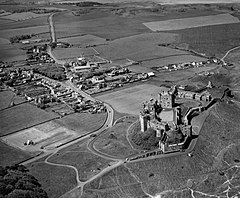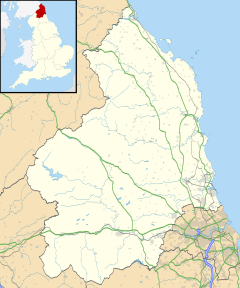Bamborough
| Bamburgh | |
|---|---|
 Bamburgh in 1973 |
|
| Bamburgh shown within Northumberland | |
| Population | 414 (2011) |
| OS grid reference | NU1734 |
| Civil parish |
|
| Unitary authority | |
| Ceremonial county | |
| Region | |
| Country | England |
| Sovereign state | United Kingdom |
| Post town | BAMBURGH |
| Postcode district | NE69 |
| Dialling code | 01668 |
| Police | Northumbria |
| Fire | Northumberland |
| Ambulance | North East |
| EU Parliament | North East England |
| UK Parliament | |

Bamburgh Lighthouse
|
|
|
Northumberland
|
|
| Location | Bamburgh, Northumberland, England |
|---|---|
| Coordinates | 55°36′59.6″N 1°43′27″W / 55.616556°N 1.72417°W |
| Year first constructed | 1910 |
| Construction | masonry building |
| Tower shape | parallelepiped building with lantern on the roof |
| Markings / pattern | white building, black lantern |
| Height | 9 m (30 ft) |
| Focal height | 12.5 m (41 ft) |
| Current lens | 1st order catadioptric fixed lens |
| Intensity | 7,140 candela |
| Range | white: 14 nmi (26 km) red and green: 11 nmi (20 km) |
| Characteristic | Oc (2) WRG 8s. |
| Admiralty number | A2810 |
| NGA number | 2252 |
| ARLHS number | ENG 004 |
| Managing agent | Trinity House |
Bamburgh (/ˈbæmbrə/ BAM-brə) is a village and civil parish on the coast of Northumberland, England. It had a population of 454, decreasing to 414 at the 2011 census.
The village is notable for the nearby Bamburgh Castle, a castle which was the seat of the former Kings of Northumbria, and for its association with the Victorian era heroine Grace Darling, who is buried there.
The extensive beach by the village was awarded the Blue Flag rural beach award in 2005. The Bamburgh Dunes, a Site of Special Scientific Interest, stand behind the beach. Bamburgh is popular with holidaymakers and is within the Northumberland Coast Area of Outstanding Natural Beauty.
Bamburgh Castle, then called Din Guardi, may have been the capital of the Brythonic kingdom of Bryneich between about AD 420 and 547. In 547 the castle was taken by the invading Angles led by Ida son of Eoppa and was renamed Bebbanburgh by one of his successors, Æthelfrith, after his wife Bebba, according to the Historia Brittonum. From then onwards the castle became the capital of the Anglian kingdom of Bernicia until it merged with its southern neighbour, Deira, in 634. After the two realms united as Northumbria the capital was moved to York.
...
Wikipedia

